Painting things that go into the aquarium with your fish can be as tempting as it is scary. Why so many people proclaim Krylon Fusion aquarium safe? Surely, there are plenty of other similar products, such as Rust-oleum, for example.

What are some differences when it comes to Krylon VS Rustoleum? Will these spray paints release harmful chemicals in your fish tank eventually?
If you’re like me, then you’re fairly obsessed with doing your research before getting into anything that may concern your fishes’ health.
A big portion of my knowledge on the subject comes from my experience, true, but not all of it.
Fortunately for me (and you), I have this one friend who used to work as a painting contractor.
He has been involved in a couple of boat painting jobs as well.
Thanks to him, now I could say that I’m an expert, sort of.
Painting and drawing are my passion.
You can probably tell from my poor attempts at crafting the heading pictures for this blog. Here’s a link to the Aquanswers homepage for you to browse them with pity if you want.
Anyway, you will be surprised at how many options are there when it comes to fish-safe paint.
However, there are a couple of circumstances you should take into consideration when approaching the matter.
Different paints will respond to surfaces differently, for example.
How to recognize an aquarium safe paint?
Here’s what to look for in a painting product if you’re about to use it inside a functional aquarium.
Paint is considered aquarium safe when:
In general, any paint that’s labeled “for use in potable containers” or as “food safe” would be safe around fish. The only rule for proper usage is waiting out a full cure. Spray paints designed for plastic will become inert after curing. A completely cured paint with fully evaporated solvents is aquarium safe. Never use paints that are mold-resistant as these are toxic to fish.
Never use paints that are mold-resistant as these are toxic to fish.
For efficiency, a good rule of thumb is that oil-based products will best stick to glass where water-based products will flake off with time.
Latex-based products will break down water-based ones.
Acrylic paint is another aquarium safe option, but it will start to chip off after some time.
Fortunately, you can prevent this by coating it with a non toxic sealant, but I’ll get to that later.
Note that all painting products will be toxic before a full cure. These materials are all hazardous and should be handled with caution during and after application.
Painting plastics before submerging them in the aquarium
For painting a PVC piece that’s going to be submerged you can use any spray paint that’s advertised as suitable for plastics.
After bonding with the surface, these paints become completely inert.
Many brands such as Valspar, Krylon, Rust-Oleum, and others, offer those.
Now, will the paint hold up to your expectations is a different thing.
That depends on your project. Let’s get straight to the examples.
Which paint will work best for you and how to choose it?

Any of them, really.
When it comes to painting plastics in the aquarium, I’ve used all of the aforementioned.
Eventually, I developed a liking for Krylon.
It serves me the best.
Other brands have their advantages too. Here’s how to choose a painting product for your fish tank:
Krylon does offer a variety of colors.
It comes in 19 different colors, which means you’ll hardly have any trouble finding what you’re looking for.
That’s unless you’re looking for something truly specific.
Rust-oleum and Valspar are more limited in their assortment.
However, both brands hold the advantage of having some really cool extraordinary color choices, where Krylon’s are pretty basic.
Plasti Dip is also safe for fish tank coloring but I don’t really recommend using it unless it fits your project idea.
It becomes rubber when everything has cured and evaporated, but it’s designed to peel off whenever you scratch it.
That wouldn’t work for my painting projects, as it is more of a test coloration, rather than a permanent solution.
Have in mind that contacting Krylon or any of the others to ask if their products are safe for use in your aquarium, won’t be productive.
They will not confirm it for liability reasons. If they state it’s safe and a fish of yours dies they stand liable. If they don’t and an incident happens it’s the user’s fault.
As all the tests and certifications are really, and I mean really, expensive it’s better for them to not take any risks.
Will it flake off?
In my experience, the reports claiming that the paint will flake off in time can be true, unless applied in a correct manner (more on that below).
Rust-oleum is advertised as water-proof and should not chip a flake anytime soon after application. With Valspar, I am yet to see flaking.
Also, some people I know reported that their Mexican turbo snails would eat off the paint…
The snails remained unharmed (which is fantastic), but my friends can’t say the same for their paintwork.
How I use spray paint for plastic objects in my aquarium?
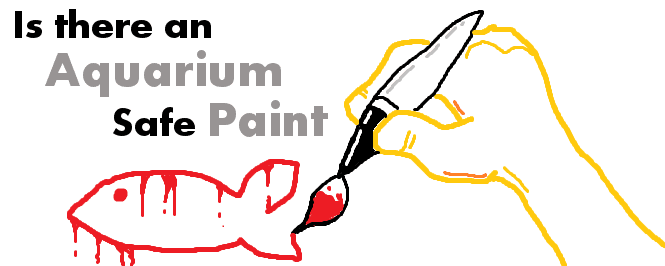
To avoid flaking over time I’d want to seal the paint and properly prepare the surface of interest:
- Clean the surface with the highest content of isopropyl alcohol available to your location. This is usually 90%.
- Wet-sand the surface of the plastic piece with a 600 grit. You are done when the plastic looks hazy and has no remaining gloss. This way the paint will be able to snugly fit the surface.
- Clean the scuffed plastic with alcohol again. Wait for it to fully dry.
- Apply 2 to 3 coats of your paint of choice. If this is not enough to hide the color underneath, continue until the desired effect is achieved. In some cases when I wanted to define an area (e.g. painting decoration of some sort), using a paintbrush seemed necessary. I would spray the paint in a container, which would allow me to use it with my brush.
- Wait out the full curing. In Krylon Fusion’s case, that’s 7 days. If you’re using another brand, check the instructions as the curing time may differ.
- Seal the painted object. My success here has been with a clear 2-part epoxy, which will provide the most durable effect. In terms of safety, you can also use a polyurethane clear coat finish or an acrylic resin-based clear matte varnish. If you go for the acrylic, be sure to get the UV-resistant one.
Following this simple step-by-step method has resulted in years of duration and unharmed aquatic life for me.
Where can you find and buy them?
Buying spray paint goes like this:
Unfortunately, not all of these are locally available to everyone.
Walmart can be offering them, but it’s not guaranteed.
In fact, the reason I tried Valspar for the first time was the absence of Krylon and Rust-oleum. Usually, Krylon is available on Amazon too. This was when I was still skeptical as to how efficient they were, so I would try them a can at a time.
Funnily enough, Valspar is no longer available at Amazon, so I switched to Krylon instead.
Which is a shame, since Valspar was the cheapest and most efficient option on the market.
Why is Krylon Fusion the most popular option?
Krylon was praised in the hobby, but what not many people know is that the “rumor” of its magic abilities started when the stuff had its OLD formula.
It was also cheap and easy to use.
More than 10 years ago they changed what was then a formula high on Volatile Organic Compound (VOC) content. The people who have been using the OF (Old Formula) Krylon will know that, as they probably noticed the difference in the instructions. The change occurred when the EPA decided it was time to put an end to paints that contain too much VOC. Note that it was not only Krylon that got “replaced”.
The OF Krylon was way more efficient at sticking to plastic.
The more VOC inside really did their job well.
What the product stood out with was its ability to etch to plastic (it was designed for that after all).
Now, combine that with being really affordable and a simplified application process.
That’s where its fame came from rather than being the safest one.
It’s why so many fishkeepers religiously advocate its use, perhaps, even unknowingly.
In fact, many other spray paints for plastics are also aquarium safe and durable.
NF (New Formula) Krylon is basically the same as all other spray paints for plastic in terms of efficiency.
OF Krylon was a lacquer, meaning it had some fast-evaporating solvents.
This allowed multiple recoats with virtually no defined wait time between them.
After EPA’s decision to forcefully cut out the fast-evaporating solvents from spray paints (which were contributing to pollution), a substitution had to be found.
A recoat window is the time frame in which a subsequent coat should be applied.
If you don’t follow these you will end up with a poor painting job.
Softer solvents are found in enamel-type paints.
Today you can be more or less certain that almost all paints will be enamels.
Although some manufacturers won’t even bother to point out what’s in their product you can still find a lacquer here and there.
A good sign would be if the cans state that their content will be “dry to the touch within one hour” combined with the “recoat anytime”.
These are most likely lacquers.
On the other hand, you can spot enamels if they have recoating windows in the instructions – “recoat within X hours” and also as stated above they cure longer (“dry to the touch after 5 hours” and above). A lacquer should not be applied over enamels, be it enamel paint or primer.
Anyway, NF Krylon claims it does not need a primer for hard plastic surfaces.
Supposedly the solvent base can “eat” its way into the plastic.
What paints that are not meant for plastic can’t offer is working well on flexible surfaces (guess what are plastics).
To remain flexible the coating windows should be respected.
You can apply recoats in the first 24 hours OR after 7 days of curing.
That sounds strange, I know.
Here’s why:
On the first day of application, there are still enough solvents to allow a reflow.
However, after that, all of them would have evaporated fully.
This results in uncured flex resins that will bubble if repainted between the end of day 1 and day 7.
Although Krylon Fusion is being advertised for use on plastics, I must point out that all of their products are suitable for that.
What makes Fusion unique is its flexing agent.
However, all Krylon paints contain a 35% acetone carrier of some sort that provides the fast drying time and the etching of the plastic.
OF and NF Krylon both have the acetone carrier, therefore the new Fusion still remains a decent choice.
For other surfaces & painting projects

Spray paints can’t be used for sealing (kind of obvious, I think).
If you do have a sealing effect in mind I can recommend you use silicone or tinted pond armor.
For a DIY 3D background project of mine, I used Drylok for the color.
Drylok is a latex-based waterproofer.
It’s white but after some research, I found out that I can mix it with concrete coloring (Quikrete Liquid Color Pigments).
Doing so was the best thing I could do to my background.
No fish were lost in this project. With that combo, you can achieve a 100% authentic rocky look.
The same method can be used for coloring driftwood branches for the inside of your tank. My experience says that 3 coats are enough.
Tannins can be healthy for aquarium life, but they will partially cloud your fish tank’s water. By the way, Krylon Fusion can work on concrete 3D backgrounds, provided the surface is sound and free of other coatings, but I haven’t really tried that.
Epoxy paints for underwater projects
It has been my experience that using epoxy paint for aquariums will give the best results in terms of endurance and safety.
In fact, I’ve often used it as a waterproofing agent in my plywood tanks due to its sealing properties.
If you’re going to attempt this, you should make sure the structure of your tank is solid or you risk potential leaks due to excessive flex.
Another great thing about epoxy paint is that it has a nice consistency which makes it easy to work with and apply.
It will, however, come with a slightly higher price tag.
You’ll need a couple of thin coats to avoid running resin.
When I’m after a bigger job, and not just painting that ugly return pipe of my filter, I would use epoxy.
I prefer using 2-part tinted epoxy.
This way I can avoid painting with a product and then seal on top, which can be a huge time-saver if you’re dealing with, say, a background for a 125-gallon aquarium.
My Conclusion
There are many paint options that will be safe for an aquarium.
The question is how well will they perform underwater and what would the durability be.
What defines your answer is the type of project you have in mind.
Tell me about your experience.

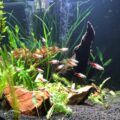
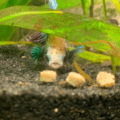

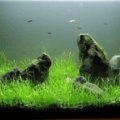
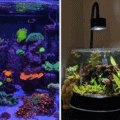


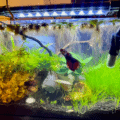
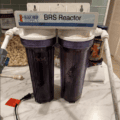
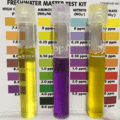
I love this post! I’m currently painting my own tank and I’m using the same paints as you mentioned. I’m really happy with the results so far!
This page seems confused about VOCs. You’re article says that the OF Krylon worked well because of the high VOC content – I take that to mean – it is a bonding agent – evaporates quickly and leaves only the paint and not the chemicals that leech into water. Another article says to only use “epoxy” paints – to avoid VOCs and then recommends the new Krylon formula. LOL
Hi,
Yes, that’s a common misconception according to my experience. VOCs sound bad (and are), but in the context of aquarium safe paint, they just used to work better. OF Krylon was better.
Best,
Momchil
I hand painted a ceramic octopus that I bought. It had been painted an ugly orange when I bought it and is for aquariums. I used acrylic paint. Now I want to seal it, to keep paint nice. What do I use for a clear coat and safe for my fish?
Hi Tonya,
I answered that under the “How I use spray paint for plastic objects in my aquarium” subheading, step #6.
Best of luck,
Momchil
Is there any alternative to Drylok it doesn’t seem available in UK cheaply. I want to paint a polystyrene background what can you recommend please much appreciated I am struggling to find something fish safe I can trust
Hi Chris,
Unfortunately, I am not that familiar with what the UK has to offer. The only thing I can recommend looking into is a pond paint of some sort.
Regards, Momchil
My experience in painting polystyrene is that enamel spray paint will melt it. I had some luck with a water based acrylic paint on polystyrene, but that was for a dry situation. Good luck
Also, I painted the acrylic paint with a brush, not a spraycan
Is Krylon Colormaxx with primer aqaurium safe?
In this thread, you mentioned acrylic paint, but didn’t go any farther. So, now what if you have a decoration that has seen better days, but you stilllove something about it. Myself, I have a set of plastic stumps, that have turned white over time. What paint is the best for these? They should have tan for the wood portion, brown and black shading for the bark portion, then has some green shades for a moss portion. If using a spray can for this, I would need 5 or 6 different colors. My question is, what paint is best for a brush on, multi colored decoration?